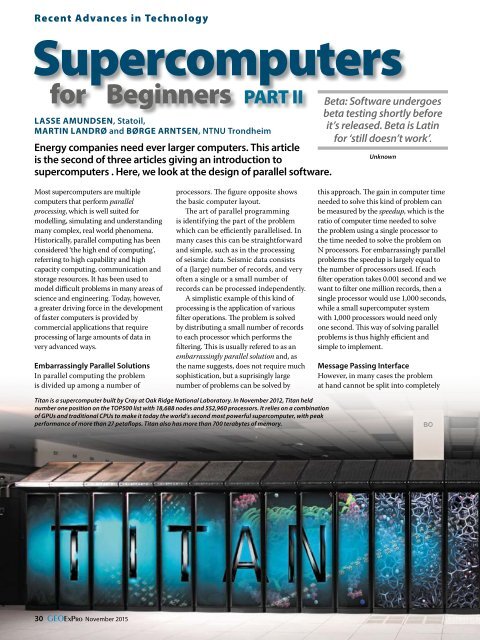Iraqi Kurdistan All in the Timing
GEO_ExPro_v12i6
GEO_ExPro_v12i6
You also want an ePaper? Increase the reach of your titles
YUMPU automatically turns print PDFs into web optimized ePapers that Google loves.
Recent Advances <strong>in</strong> Technology<br />
Supercomputers<br />
for Beg<strong>in</strong>ners PART II<br />
LASSE AMUNDSEN, Statoil,<br />
MARTIN LANDRØ and BØRGE ARNTSEN, NTNU Trondheim<br />
Energy companies need ever larger computers. This article<br />
is <strong>the</strong> second of three articles giv<strong>in</strong>g an <strong>in</strong>troduction to<br />
supercomputers . Here, we look at <strong>the</strong> design of parallel software.<br />
Beta: Software undergoes<br />
beta test<strong>in</strong>g shortly before<br />
it’s released. Beta is Lat<strong>in</strong><br />
for ‘still doesn’t work’.<br />
Unknown<br />
Most supercomputers are multiple<br />
computers that perform parallel<br />
process<strong>in</strong>g, which is well suited for<br />
modell<strong>in</strong>g, simulat<strong>in</strong>g and understand<strong>in</strong>g<br />
many complex, real world phenomena.<br />
Historically, parallel comput<strong>in</strong>g has been<br />
considered ‘<strong>the</strong> high end of comput<strong>in</strong>g’,<br />
referr<strong>in</strong>g to high capability and high<br />
capacity comput<strong>in</strong>g, communication and<br />
storage resources. It has been used to<br />
model difficult problems <strong>in</strong> many areas of<br />
science and eng<strong>in</strong>eer<strong>in</strong>g. Today, however,<br />
a greater driv<strong>in</strong>g force <strong>in</strong> <strong>the</strong> development<br />
of faster computers is provided by<br />
commercial applications that require<br />
process<strong>in</strong>g of large amounts of data <strong>in</strong><br />
very advanced ways.<br />
Embarrass<strong>in</strong>gly Parallel Solutions<br />
In parallel comput<strong>in</strong>g <strong>the</strong> problem<br />
is divided up among a number of<br />
processors. The figure opposite shows<br />
<strong>the</strong> basic computer layout.<br />
The art of parallel programm<strong>in</strong>g<br />
is identify<strong>in</strong>g <strong>the</strong> part of <strong>the</strong> problem<br />
which can be efficiently parallelised. In<br />
many cases this can be straightforward<br />
and simple, such as <strong>in</strong> <strong>the</strong> process<strong>in</strong>g<br />
of seismic data. Seismic data consists<br />
of a (large) number of records, and very<br />
often a s<strong>in</strong>gle or a small number of<br />
records can be processed <strong>in</strong>dependently.<br />
A simplistic example of this k<strong>in</strong>d of<br />
process<strong>in</strong>g is <strong>the</strong> application of various<br />
filter operations. The problem is solved<br />
by distribut<strong>in</strong>g a small number of records<br />
to each processor which performs <strong>the</strong><br />
filter<strong>in</strong>g. This is usually refered to as an<br />
embarrass<strong>in</strong>gly parallel solution and, as<br />
<strong>the</strong> name suggests, does not require much<br />
sophistication, but a supris<strong>in</strong>gly large<br />
number of problems can be solved by<br />
this approach. The ga<strong>in</strong> <strong>in</strong> computer time<br />
needed to solve this k<strong>in</strong>d of problem can<br />
be measured by <strong>the</strong> speedup, which is <strong>the</strong><br />
ratio of computer time needed to solve<br />
<strong>the</strong> problem us<strong>in</strong>g a s<strong>in</strong>gle processor to<br />
<strong>the</strong> time needed to solve <strong>the</strong> problem on<br />
N processors. For embarrass<strong>in</strong>gly parallel<br />
problems <strong>the</strong> speedup is largely equal to<br />
<strong>the</strong> number of processors used. If each<br />
filter operation takes 0.001 second and we<br />
want to filter one million records, <strong>the</strong>n a<br />
s<strong>in</strong>gle processor would use 1,000 seconds,<br />
while a small supercomputer system<br />
with 1,000 processors would need only<br />
one second. This way of solv<strong>in</strong>g parallel<br />
problems is thus highly efficient and<br />
simple to implement.<br />
Message Pass<strong>in</strong>g Interface<br />
However, <strong>in</strong> many cases <strong>the</strong> problem<br />
at hand cannot be split <strong>in</strong>to completely<br />
Titan is a supercomputer built by Cray at Oak Ridge National Laboratory. In November 2012, Titan held<br />
number one position on <strong>the</strong> TOP500 list with 18,688 nodes and 552,960 processors. It relies on a comb<strong>in</strong>ation<br />
of GPUs and traditional CPUs to make it today <strong>the</strong> world’s second most powerful supercomputer, with peak<br />
performance of more than 27 petaflops. Titan also has more than 700 terabytes of memory.<br />
30 GEOExPro November 2015


